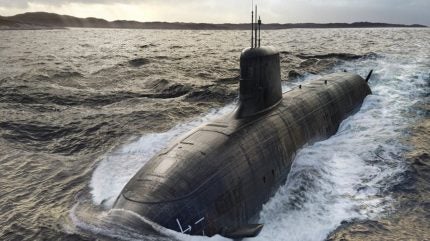
Naval chiefs from among the trilateral AUKUS alliance visited HMAS Stirling, a Western Australia naval base, where they agreed to strengthen their ties in a statement of intent for lethality.
Australia’s Chief of Navy, Vice Admiral Mark Hammond, hosted his counterparts, the US Chief of Naval Operations, Admiral Lisa Franchetti, and the UK First Sea Lord and Chief of Naval Staff, Admiral Ben Key, ahead of the Indian Ocean Defence and Security 2024 Conference in Perth this week.

Discover B2B Marketing That Performs
Combine business intelligence and editorial excellence to reach engaged professionals across 36 leading media platforms.
The three chiefs toured the base, followed by a meet-and-greet with Australian submariners onboard a conventional diesel-electric Collins-class submarine.
Nearly three-years-old, the AUKUS security partnership serves as a regional deterrent in the Indo Pacific, where the UK and US are assisting the Commonwealth in acquiring nuclear-powered submarines, while also collaborating in emerging technology areas.
HMAS Stirling
From as early as 2027, the partners will participate in a rotational presence at HMAS Stirling, of one UK Astute-class and up to four US Virginia-class – nuclear-powered attack submarines (SSN). This presence will be known as Submarine Rotational Force – West (SRF-West).
This commitment comes under the first phase of the AUKUS roadmap. It includes increased SSN port visits aimed to expand Australia’s knowledge of SSNs ahead of establishing SRF-W from 2027.

US Tariffs are shifting - will you react or anticipate?
Don’t let policy changes catch you off guard. Stay proactive with real-time data and expert analysis.
By GlobalDataAustralian sailors will deploy on UK and US boats to develop at-sea experience with naval nuclear propulsion, while Australian maintenance personnel will support these submarines at shore.
Three Royal Australian Navy officers have already graduated from the US Navy’s Nuclear Power Training Unit (NPTU) in Charleston, South Carolina in January this year. Earlier this month, three more RAN officers completed the UK Royal Navy’s nine-month training for operating a nuclear reactor.
Enhanced lethality?
During the visit, the three chiefs signed a Statement of Intent (SOI) for lethality, “which documents the three navies’ collective commitment to the enhanced lethality of their surface combatant, and submarine fleets,” vowed the Australian Defence Force.
However, this latest SOI remains ambiguous in defining what greater lethality might look like. Neither does the agreement stipulate whether this enhanced form of lethality will be developed under the first pillar on the SSN capability, or the second pillar on emerging technologies.
Insofar as programmes such as AUKUS are an effective deterrent, an adversary must be able to clearly recognise the detriment of the allies’ decision to enhance lethality further.



